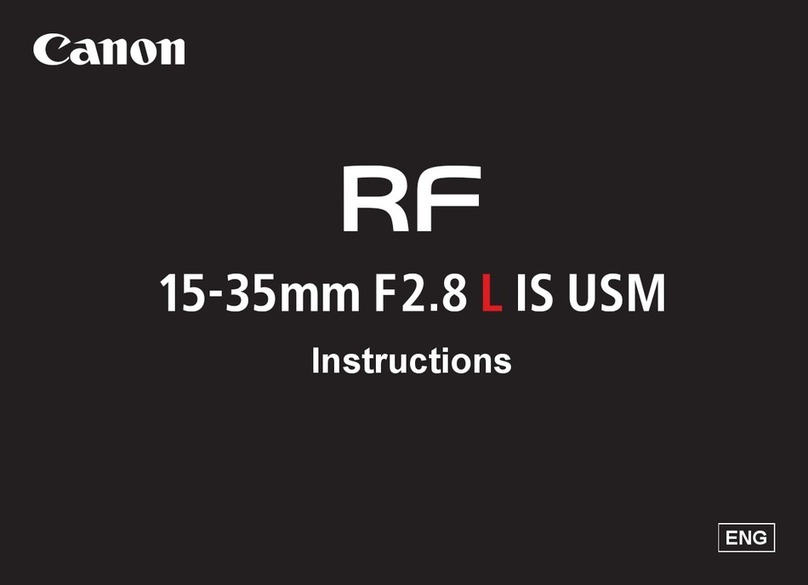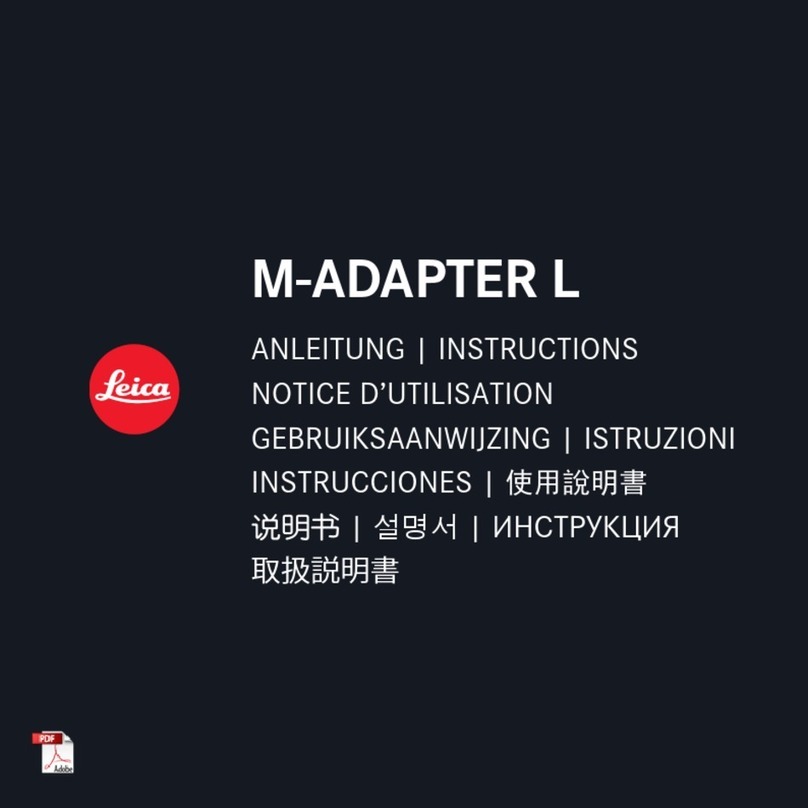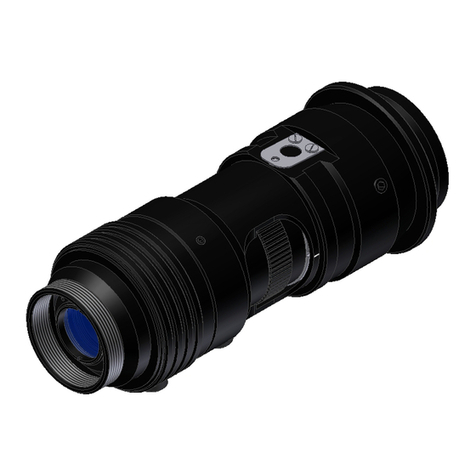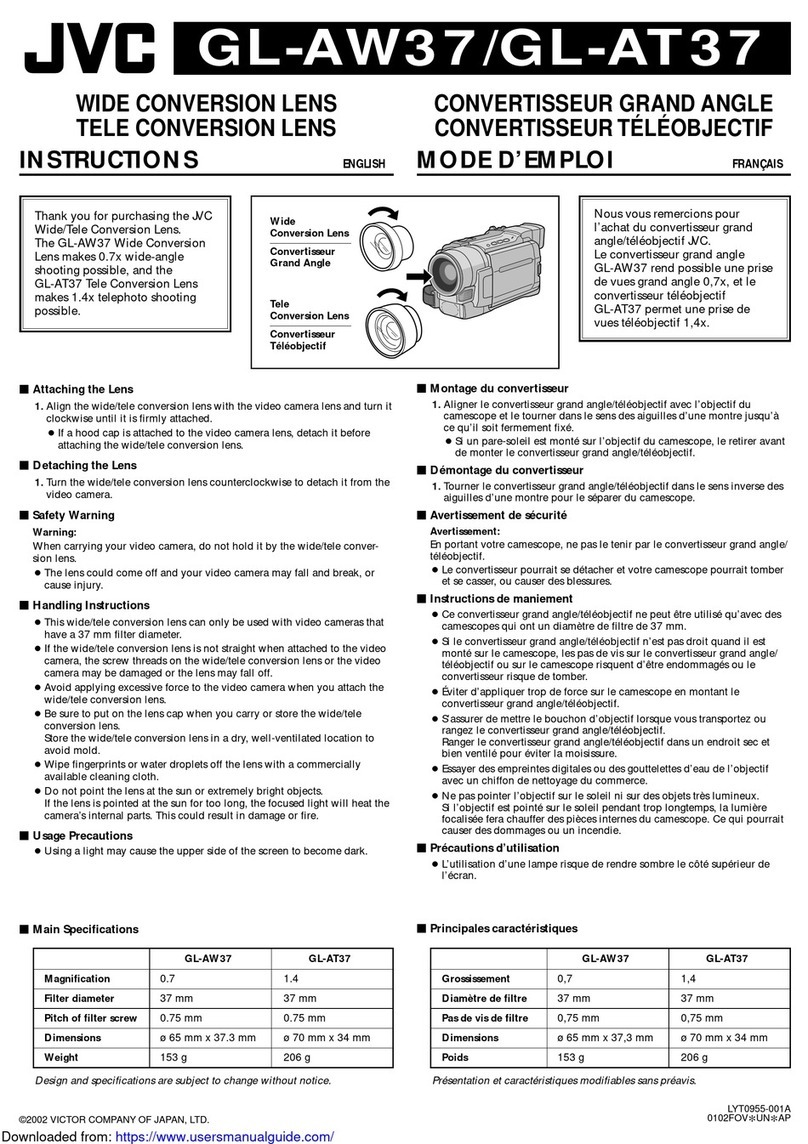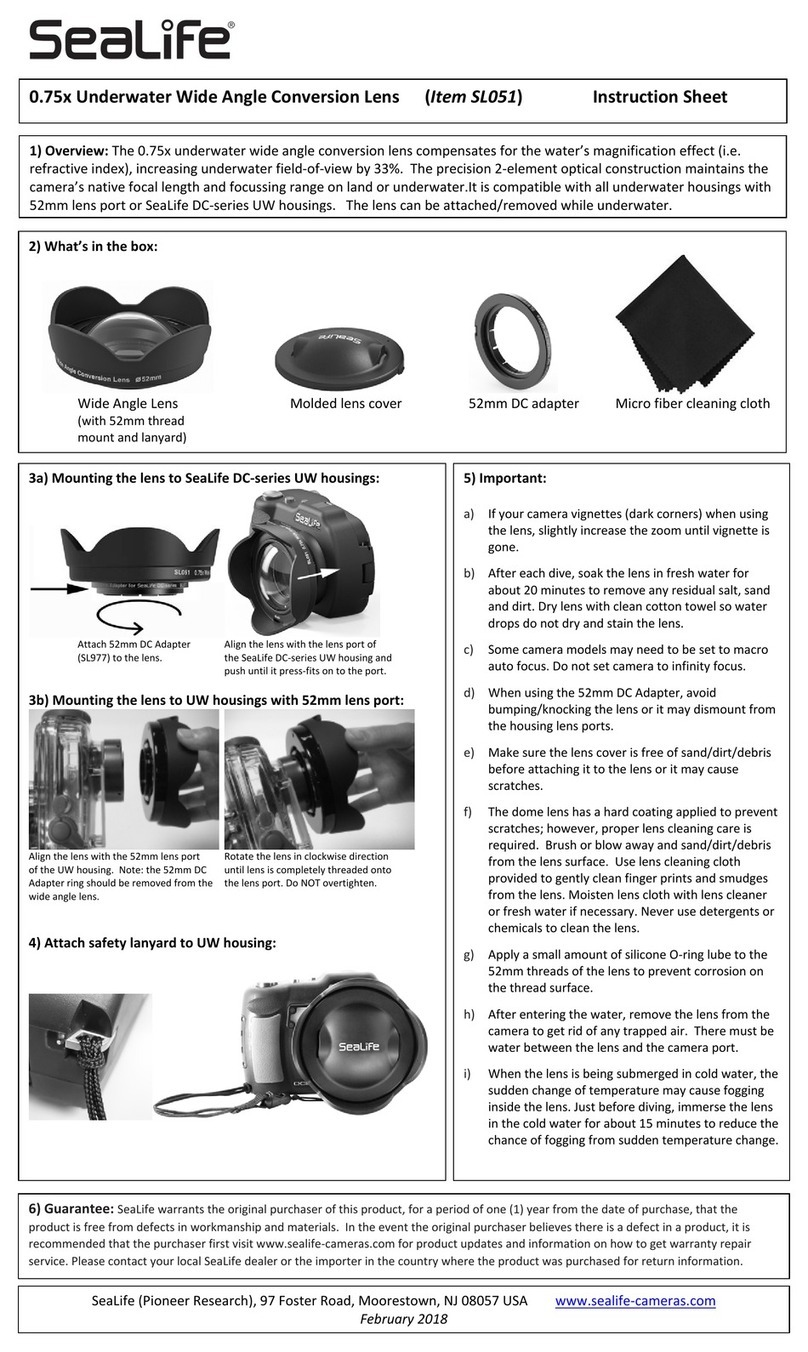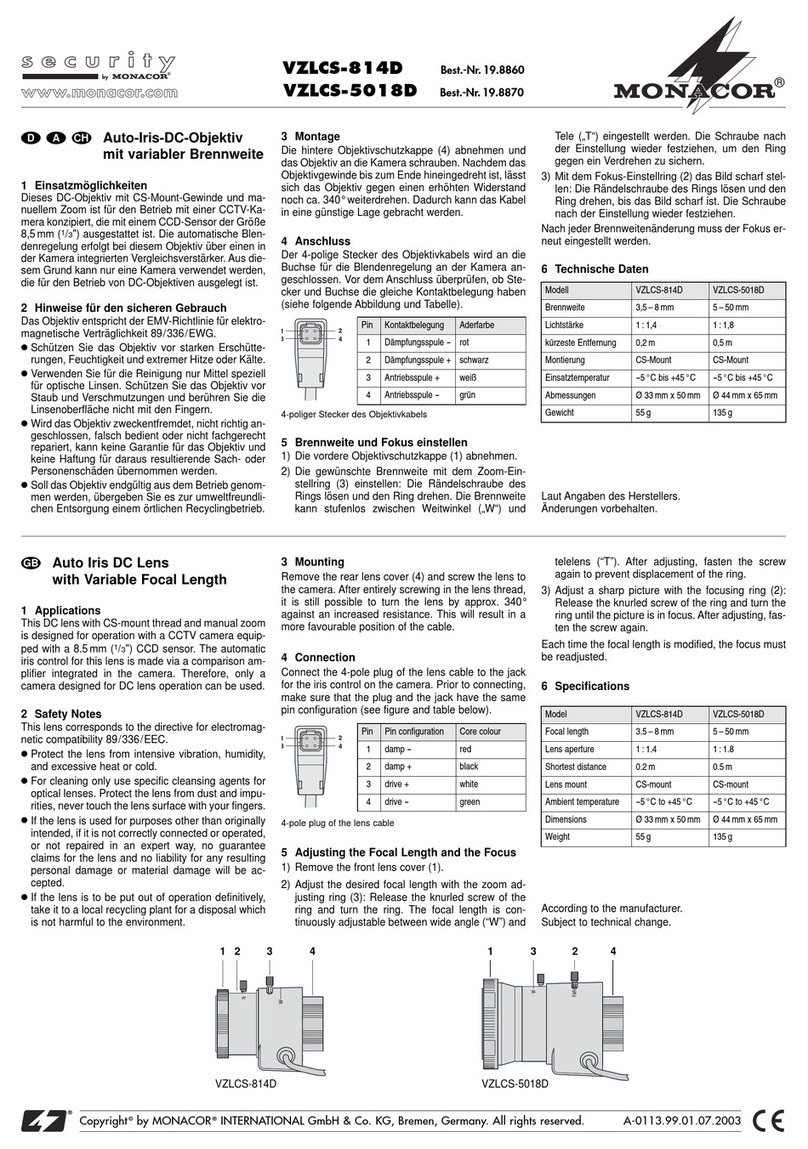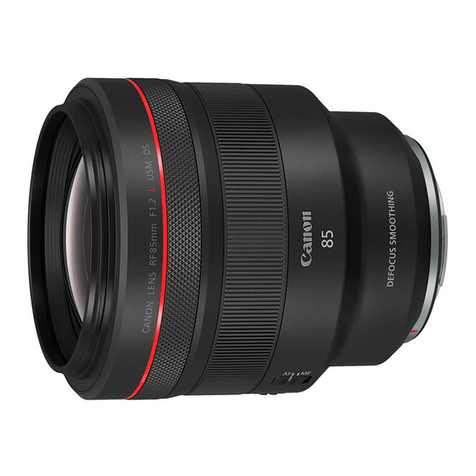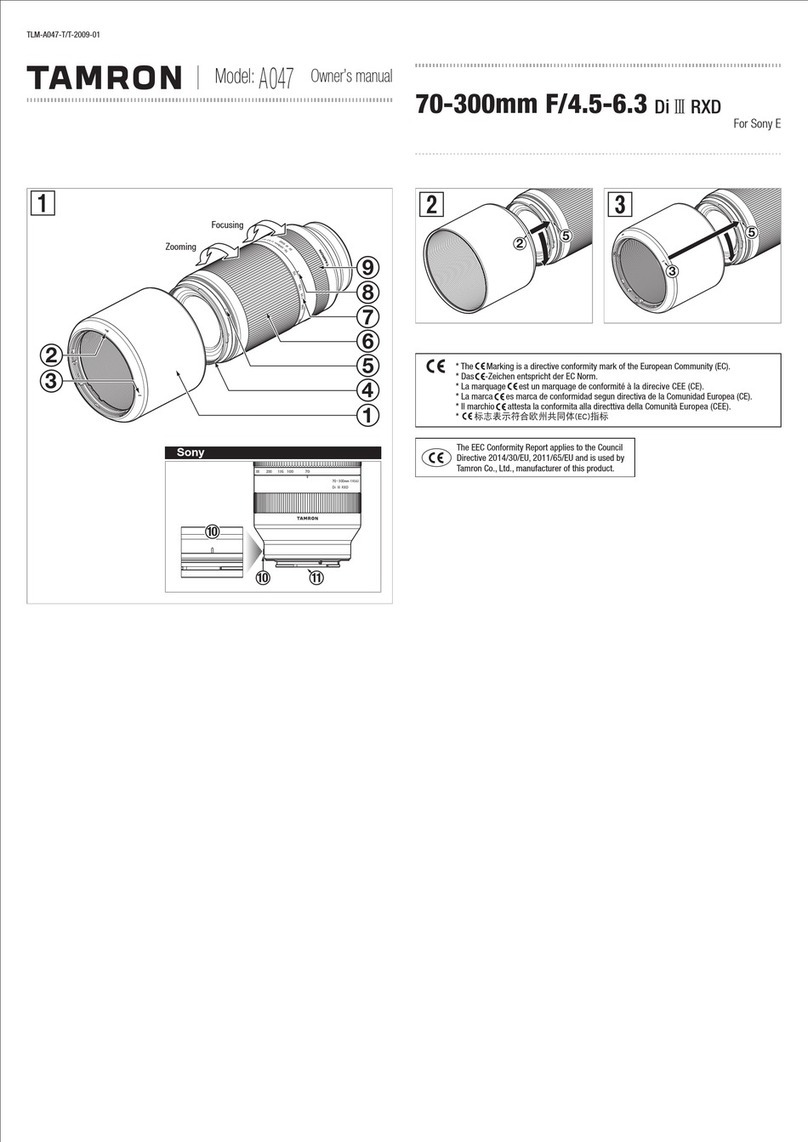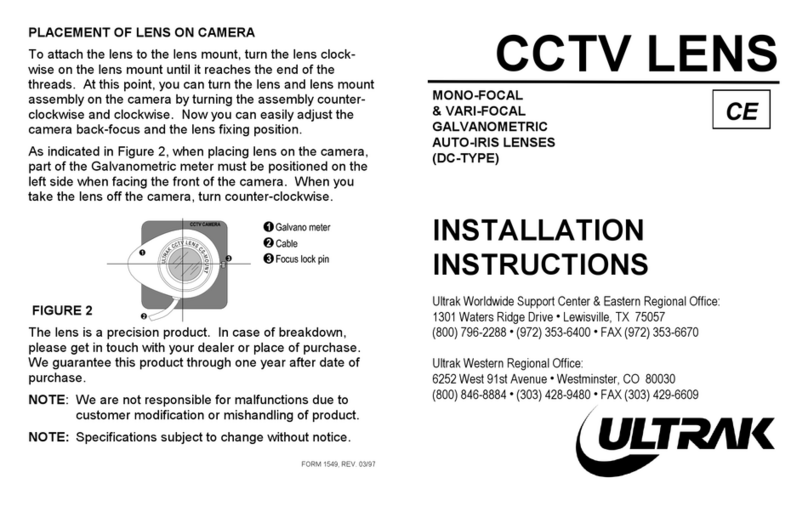Bausch & Lomb Soflens daily disposable Toric hilafilcon B User manual

© Bausch & Lomb Incorporated. ®/TM denote trademarks of Bausch & Lomb Incorporated. All rights reserved worldwide. Printed in U.S.A.
SL-5351 / 8077201
Visibility Tinted Contact Lenses
PATIENT INFORMATION BOOKLET
FOR SINGLE USE DISPOSABLE WEAR
CAUTION: Federal (U.S.A.) law restricts this device to sale by or on the order of a licensed practitioner.

Table of Contents
Page
Introduction 2
Wearing Restrictions and Indications 3
Contraindications (Reasons Not To Use) 3
Warnings 4
Precautions 5
Topics to Discuss with the Eye Care Professional 6
Adverse Reactions (Problems and What To Do) 7
Personal Cleanliness and Lens Handling 8
Preparing the Lens for Wearing 8
Handling the Lenses 8
Placing the Lens on the Eye 9
Centering the Lens 10
Removing the Lens 10
Care for a Sticking (Nonmoving) Lens 11
Emergencies 11
Page
Lens Rewetting Products Available
from Bausch & Lomb 11
Instructions for the Monovision Wearer 12
Personal Wearing Schedule Record 13
Check-Up Visits 15
Eye Care Professional Information 16
Glossary of Medical Terms 17
Symbol Reference Guide 18
For labels and cartons:
Quality System Certification Symbol
Fee Paid for Waste Management
Sterile Using Steam or Dry Heat
See Instruction Leaflet
Diameter
Use by Date (Expiration Date)
Batch Code
Authorized Representative in
European Community
Caution: Federal (U.S.A.) law restricts
this device to sale by or on the order
of a licensed practitioner
Diopter (Lens Power)
Single Use Only
Base Curve
Sphere Power (Diopters)
Cylinder Axis (Degrees)
Cylinder Power (Diopters)
Symbol Reference Guide
18

17 2
Introduction
The instructions in this booklet apply to the Bausch &
Lomb® SofLens® daily disposable Toric (hilafilcon B)
Visibility Tinted Contact Lenses. If you have received or
are considering another brand of contact lenses, do not
use this booklet. Ask your eye care professional for the
patient booklet or instructions that apply to your brand
or type of contact lenses. For Bausch & Lomb SofLens
daily disposable Toric (hilafilcon B) Visibility Tinted
Contact Lenses, it is essential to your safety that you
read and understand the information and instructions
in this booklet, and have your eye care professional
answer any questions, both before and after you receive
contact lenses.
Wearing contact lenses is different from wearing
eyeglasses. Because they are worn directly on your
eyes, contact lenses affect the way in which your eyes
function. These effects tend to increase with the length
of time that the lenses remain on your eyes between
removals. Although the great majority of people
successfully wear contact lenses without problems,
before you decide whether to begin or to continue
wearing contact lenses for daily wear, you should
discuss with your eye care professional the effects of
contact lenses on your eyes and the risks associated
with wearing contact lenses. You also should read the
sections of this booklet entitled “Warnings”, “Adverse
Reactions”, “Precautions”, and “Wearing Restrictions
and Indications”. Ask your eye care professional to
explain anything that you do not understand, including
any additional restrictions which may be given to you
by your eye care professional. Your Bausch & Lomb
SofLens daily disposable Toric (hilafilcon B) Visibility
Tinted Contact Lenses have been prescribed for single-
use disposable wear, and should be discarded each time
lenses are removed from your eyes.
You also need to remember that soft contact lenses,
including those covered by this booklet, are made of a
type of plastic that absorbs liquids, vapors, and small
particles, and, for some people, may collect deposits
from your natural eye fluids. Therefore, you should
strictly follow the instructions contained in this booklet
entitled “Personal Cleanliness and Lens Handling”, as
well as the written information leaflets accompanying
the lens care products that you buy and any other
instructions given to you by your eye care professional.
Any failure to follow these instructions and the wearing
restrictions will increase the chances of contamination,
damage to the lenses, or a build-up of deposits on the
lenses, which can lead to serious, sight-threatening eye
infections and injuries.
Adherence to your prescribed wearing schedule, and
regular check-up visits to your eye care professional are
also necessary for the proper and safe use of contact
lenses.
It is important to not wear your lenses longer than
recommended by your eye care professional since
doing so increases the risk of adverse effects.
Spaces are provided in the back of this booklet for you
to record your personal wearing schedule and schedule
of follow-up visits. Soft contact lenses generally are
comfortable from the beginning. Therefore, be sure to
follow the wearing schedule prescribed for you, and
do not over wear your lenses for longer periods than
your prescribed wearing schedule simply because they
remain comfortable and you are not experiencing a
problem. Only your eye care professional, through a
professional examination, can determine how your eyes
Glossary of Medical Terms
Ametropia Abnormal vision requiring correction for proper focus
Myopia Nearsighted
Hyperopia Farsighted
Aphakic Lacking a crystalline lens (focusing lens inside the eye)
Non-aphakic Not lacking a crystalline lens
Acute inflammation Sudden swelling, redness and pain
Subacute inflammation Gradual swelling, redness and pain
Anterior chamber Internal portion of the eye, between the cornea and iris
Cornea Clear, front covering of the eye
Conjunctiva Membrane that lines the eyelids and the white part of the eye
Corneal ulcer A sore or lesion on the cornea, which left untreated could lead
to permanent loss of vision
Microbial keratitis An infected corneal ulcer
Hypoxia Lack of oxygen
Epithelial Layer of cells on the surface of the cornea
Epithelial microcysts A small abnormal structure (cyst) in the front surface of the eye
Endothelial polymegathism Irregular cell size and shape
Neovascularization Small blood vessels growing into the cornea
Iritis Internal inflammation of the colored part of the eye (iris)

163
are reacting to the contact lenses and whether there
are any early signs of possible problems.
If problems or symptoms should occur, immediately
remove your lenses and follow the steps described in
the section of this booklet entitled “Warnings” and
“Adverse Reactions”. (Refer to “Glossary of Medical
Terms” for description of medical terms used in this
booklet). Prompt attention to problems is essential and
may require immediate professional care.
Remember, when wearing soft contact lenses your eyes
should look and feel good, and your vision should be
clear.
The Bausch & Lomb SofLens daily disposable Toric
(hilafilcon B) Visibility Tinted Contact Lens is indicated
for the daily wear correction of refractive ametropia
(myopia, hyperopia, and astigmatism) in not-aphakic
persons with non-diseased eyes, exhibiting astigmatism
of 5.00 diopters or less, that does not interfere with
visual acuity. The lens may be prescribed in spherical
powers ranging from +20.00D to -20.00D.
The lens has been prescribed for single-use disposable
wear, and is to be discarded after each removal.
Wearing Restrictions and Indications
DO NOT USE the Bausch & Lomb SofLens daily
disposable Toric (hilafilcon B) Visibility Tinted Contact
Lens when any of the following conditions exist:
• Acuteandsubacuteinflammationorinfectionofthe
anterior chamber of the eye
• Anyeyedisease,injury,orabnormalitythataffects
the cornea, conjunctiva, or eyelids
• Severeinsufficiencyoflacrimalsecretion
(dry eyes)
• Cornealhypoesthesia(reducedcornealsensitivity)
• Anysystemicdiseasethatmayaffecttheeyeorbe
exaggerated by wearing contact lenses
• Allergicreactionsofocularsurfacesoradnexa
(surrounding tissue) that may be induced or
exaggerated by wearing contact lenses
• Anyactivecornealinfection(bacterial,fungal,or
viral)
• Ifeyesbecomeredorirritated
Contraindications (Reasons Not To Use)
Eye Care Professional Information
PLEASE FILL OUT FOR READY USE
Name: __________________________________________________________________________________________
Address: ________________________________________________________________________________________
Phone: _______________________________________________________________________________________
Other Information: ______________________________________________________________________________
______________________________________________________________________________________________
_______________________________________________________________________________________________
______________________________________________________________________________________________
IMPORTANT: In the event that you experience any difficulty wearing your lenses or you
do not understand the instructions given to you, DO NOT WAIT for your next appointment.
TELEPHONE YOUR EYE CARE PROFESSIONAL IMMEDIATELY.
Bausch & Lomb Incorporated
Rochester, New York 14609

15 4
You should be aware of and fully discuss with your eye
care professional the following warnings pertaining to
contact lens wear:
• Problemswithcontactlensescouldresultinserious
injury to your eye. It is essential that you follow
your eye care professional’s direction and all labeling
instructions for proper use of lenses. Eye problems,
including corneal ulcers, can develop rapidly and
lead to loss of vision.
• Dailywearlensesarenotindicatedforovernight
wear, and you should not wear lenses while
sleeping. Clinical studies have shown that the risk
of serious adverse reactions is increased when daily
wear lenses are worn overnight.
• Strictcompliancewithyourwearingrestrictions,
wearing schedule, and follow-up visit schedule
should be followed.
• Studieshaveshownthatcontactlenswearerswho
are smokers have a higher incidence of adverse
reactions than nonsmokers.
• Ifyouexperienceeyediscomfort,excessivetearing,
vision changes, or redness of the eye, you should
immediately remove lenses and promptly contact
your eye care professional.
WarningsCheck-Up Visits
Regular check-up examinations by your eye care professional are an important part of wearing
contact lenses. It is recommended that you follow your eye care professional’s directions for follow
up examinations. Keep all appointments for your check-up visits. If you move to a new city, ask
your present eye care professional to refer you to a contact lens professional in your new location.
Use the space below to record your appointments.
VISIT SCHEDULE
1. _____________________________________________________________________________
Date Time
2. _____________________________________________________________________________
Date Time
3. _____________________________________________________________________________
Date Time
4. _____________________________________________________________________________
Date Time
5. _____________________________________________________________________________
Date Time
6. _____________________________________________________________________________
Date Time
7. _____________________________________________________________________________
Date Time
8. _____________________________________________________________________________
Date Time
9. _____________________________________________________________________________
Date Time
10. ____________________________________________________________________________
Date Time

5 14
You should be aware of and fully discuss with your eye
care professional the following safety precautions:
Handling Precautions:
• Alwayswashandrinsehandsbeforehandling
lenses. Do not get cosmetics, lotions, soaps, creams,
deodorants, or sprays in the eyes or on the lenses.
It is best to put on lenses before putting on makeup.
Water-base cosmetics are less likely to damage
lenses than oil-base products.
• Beforeleavingyoureyecareprofessional’soffice
be certain that you are able to remove your lenses
promptly or have someone else available to remove
them for you.
• Becertainthatthefingersorhandsarefreeof
foreign materials before touching your lenses, as
microscopic scratches of the lenses may occur,
causing distorted vision and/or injury to the eye.
• Alwayshandleyourlensescarefullyandavoid
dropping them.
• Donottouchthelenswithyourfingernails.
• Carefullyfollowthehandling,insertion,removal,
cleaning disinfecting, storing and wearing
instructions in this booklet and those prescribed by
your eye care professional.
• Neverusetweezersorothertoolstoremoveyour
lenses from the lens container unless specifically
indicated for that use. Pour the lens into the hand.
Lens Wearing Precautions:
• Neverwearyourlensesbeyondtheperiod
recommended by your eye care professional.
• Ifthelenssticks(stopsmoving)ontheeye,follow
the recommended directions on Care for a Sticking
(Nonmoving) Lens. The lens should move freely
on the eye for the continued health of the eye. If
nonmovement of the lens continues, you should
immediately consult your eye care professional.
• Avoid,ifpossible,allharmfulorirritatingvaporsand
fumes when wearing lenses.
• Ifaerosolproductsareusedwhilewearinglenses,
exercise caution and keep eyes closed until the
spray has settled.
Precautions DAY DATE HOURS TO BE WORN HOURS WORN
11
12
13
14
15
16
17
18
19
20
21
22

13 6
• Aswithanycontactlens,follow-upvisitsare
necessary to assure the continuing health of the
eyes. You should be instructed as to a recommended
follow-up schedule.
• Patientsshouldbeadvisedaboutwearinglenses
during sporting and water related activities.
Exposure to water while wearing contact lenses
in activities such as swimming, water skiing and
hot tubs may increase the risk of ocular infection
including but not limited to Acanthamoeba keratitis.
• Alwayscontactyoureyecareprofessionalbefore
using any medicine in the eyes.
Who should know that you are wearing contact lenses:
• Informyourdoctor(healthcareprofessional)about
being a contact lens wearer.
• Alwaysinformyouremployerofbeingacontact
lens wearer. Some jobs may require the use of eye
protection equipment or may require that you not
wear lenses.
Ask your eye care professional whether there are any
other wearing restrictions that apply to you. Write those
restrictions in the spaces provided below and follow
them carefully:
Personal Wearing Record Schedule
Your eye care professional will prescribe your own individual lens wearing schedule and lens replacement schedule.
Use the space below to record your schedule and wearing record.
DAY DATE HOURS TO BE WORN HOURS WORN
1
2
3
4
5
6
7
8
9
10
Topics to Discuss with the Eye Care Professional

7 12
You should be aware that the following problems may
occur:
• Eyesstinging,burning,itching(irritation),orother
eye pain
• Comfortislessthanwhenlenswasfirstplaced
on eye
• Abnormalfeelingofsomethingintheeye(foreign
body, scratched area)
• Excessivewatering(tearing)oftheeyes
• Unusualeyesecretions
• Rednessoftheeyes
• Reducedsharpnessofvision(poorvisualacuity)
• Blurredvision,rainbows,orhalosaroundobjects
• Sensitivitytolight(photophobia)
• Dryeyes
If you notice any of the above, you should:
• Immediately remove your lenses.
• Ifthediscomfortorproblemstops,thenlookclosely
at the lens. If the lens is in any way damaged,
do not put the lens back on your eye. You should
discard the lens and insert a new lens on the eye.
If the problem continues, you should immediately
remove the lenses and consult your eye care
professional.
When any of the above problems occur, a
serious condition such as infection, corneal ulcer,
neovascularization, or iritis may be present. You should
keep the lens off your eye and seek immediate
professional identification of the problem and prompt
treatment to avoid serious eye damage.
Adverse Reactions (Problems And What To Do)
• Youshouldbeawarethataswithanytypeoflens
correction, there are advantages and compromises
to monovision contact lens therapy. The benefit
of clear near vision in straight ahead and upward
gaze that is available with monovision may be
accompanied by a vision compromise that may
reduce your visual acuity and depth perception for
distance and near tasks.
• Somepatientshaveexperienceddifficultyadapting
to monovision contact lens therapy. Symptoms,
such as mild blurred vision, dizziness, headaches
and a feeling of slight imbalance, may last for a
brief minute or for several weeks as adaptation
takes place. The longer these symptoms persist, the
poorer your prognosis for successful adaptation.
• Youshouldavoidvisuallydemandingsituations
during the initial adaptation period. It is
recommended that you first wear these contact
lenses in familiar situations, which are not visually
demanding. For example, it might be better to be
a passenger rather than a driver of an automobile
during the first few days of lens wear. It is
recommended that you only drive with monovision
correction if you pass your state drivers license
requirements with monovision correction.
• Somemonovisionpatientswillneverbefully
comfortable functioning under low levels of
illumination, such as driving at night. If this
happens, you may want to discuss with your eye
care professional having additional contact lenses
prescribed so that both eyes are corrected for
distance when sharp distance binocular vision is
required.
• Ifyourequireverysharpnearvisionduring
prolonged close work, you may want to have
additional contact lenses prescribed so that both
eyes are corrected for near when sharp near
binocular vision is required.
• Somemonovisionpatientsrequiresupplemental
spectacles to wear over the monovision correction
to provide the clearest vision for critical tasks. You
should discuss this with your eye care professional.
• Itisimportantthatyoufollowyoureyecare
professional’s suggestions for adaptation to
monovision contact lens therapy. You should discuss
any concerns that you may have during and after
the adaptation period.
• The decision to be fit with a monovision
correction is most appropriately left to the eye
care professional in conjunction with you, after
carefully considering and discussing your needs.
Instructions for the Monovision Wearer

11 8
1. PREPARINg ThE LENs FOR WEARINg:
It is essential that you learn and use good hygienic
methods in the care and handling of your new lenses.
Cleanliness is the first and most important aspect of
proper contact lens care. In particular, your hands
should be clean and free of any foreign substances
when you handle your lenses. The procedures are:
• Alwayswashyourhandsthoroughlywithamild
soap, rinse completely, and dry with a lint-free towel
before touching your lenses.
• Avoidtheuseofsoapscontainingcoldcream,lotion,
or oily cosmetics before handling your lenses, since
these substances may come into contact with the
lenses and interfere with successful wearing.
• Handleyourlenseswithyourfingertips,andbe
careful to avoid contact with fingernails. It is helpful
to keep your fingernails short and smooth.
Start off correctly by getting into the habit of always
using proper hygienic procedures so that they become
automatic.
2. hANdLINg ThE LENsEs:
• Developthehabitofalwaysworkingwiththesame
lens first to avoid mix-ups.
• Positionthelensonyourindexfingerandexamine
it to be sure that it is moist, clean, clear and free of
any nicks or tears.
• Shouldyouaccidentallyplaceaninside-outlenson
your eye, one of the following signs should signal
you to remove and replace it correctly.
a. Less than usual comfort
b. The lens may fold on the eye
c. Excessive lens movement on blink
d. Blurred vision
• Ifthelensfoldsandstickstogether:Placethelens
in the palm of your hand and wet thoroughly with
the recommended rewetting solution. (Refer to
the Lens Rewetting Products Chart for the solutions
available from Bausch & Lomb). Then GENTLY rub the
lens between your index finger and palm in a gentle
back and forth motion.
• Ifthelensflattensordrapesacrossyourfinger,
the lens or your finger may be too wet. To correct
this, dry your finger by transferring the lens several
times from one index finger to the other, drying the
opposite finger each time.
Personal Cleanliness and Lens Handling
6. CARE FOR A sTICKINg (NONMOVINg) LENs
It is important to the health of your eyes that your
contact lenses move freely. If a lens sticks (stops
moving), put a few drops of the lubricating or rewetting
solution recommended by your eye care professional
into your eye. In this case, do not use plain water or
anything other than the recommended solutions. Do
not attempt to remove a lens that is sticking, which
could damage your eye. If the lens does not begin to
move when you blink after several applications of the
solution or drops, contact your eye care professional
immediately. Do not attempt to remove the lens except
on the advice of your eye care professional.
7. EMERgENCIEs
If chemicals of any kind (household products, gardening
solutions, laboratory chemicals, etc.) are splashed
into your eyes, you should: FLUSH EYES IMMEDIATELY
WITH TAP WATER AND THEN REMOVE LENSES PROMPTLY.
CONTACT YOUR EYE CARE PROFESSIONAL OR VISIT A
HOSPITAL EMERGENCY ROOM WITHOUT DELAY.
LENs REWETTINg PROduCTs AVAILABLE FROM
BAusCh & LOMB:
Bausch & Lomb ReNu® Lubricating and Rewetting Drops
Bausch & Lomb Sensitive Eyes® Drops

9
3. PLACING THE LENS ON THE EYE
There are other methods of lens placement. If the
following methods are difficult for you, your eye care
professional will provide you with an alternate method.
Note: If after placement of the lens, your vision is blurred,
check for the following:
• Thelensisnotcenteredontheeye(see“Centering
the Lens,” next in this booklet).
• Ifthelensiscentered,removethelens(see
“Removing the Lens” section) and check for the
following:
a. Cosmetics or oils on the lens. Clean, rinse,
disinfect, and place on the eye again.
b. The lens is on the wrong eye.
c. The lens is inside-out (it would also not be as
comfortable as normal).
If you find that your vision is still blurred after checking
the above possibilities, remove both lenses and consult
your eye care professional.
The One Hand Placement Technique
Place the lens on your index finger. Head up, looking
straight ahead, pull down your lower eyelid with the
middle finger of your placement hand. Look up steadily
at a point above you. Then place the lens on the lower
white part of your eye. Remove your index finger and
slowly release the lower lid. Look down to position the
lens properly. Close your eyes for a moment; the lens
will center itself on your eye.
10
The Two Hand Placement Technique
With the lens on your index finger, use the middle
finger of the other hand to pull the upper lid against
the brow. Use the middle finger of your placement
hand to pull down the lower lid and then place the lens
centrally on your eye. While holding this position, look
downward to position the lens properly. Slowly release
your eyelids.
If the lens feels uncomfortable, then:
Look in a mirror and gently place a finger on the edge
of the contact lens and slowly slide the lens away from
your nose while looking in the opposite direction. Then
by blinking, the lens will recenter itself. If the lens still
feels uncomfortable, follow the steps described in the
section of this booklet entitled “Adverse Reactions.”
4. CENTERING THE LENS
Very rarely, a lens that is on the cornea will be
displaced onto the white part of the eye during lens
wear. This can also occur during placement and
removal of the lenses if the correct techniques are not
performed properly. To center a lens follow one of the
procedures below.
• Holdtheupperandlowereyelidsopenwithyour
fingers. Then, while looking in a mirror, gently place
a finger on the contact lens and gently slide the lens
towards the center of the eye.
Or
• Holdtheupperandlowereyelidsopenwithyour
fingers. Then, while looking in a mirror, move your
eye towards the lens to place it on the center of
the eye.
5. REMOVING THE LENS
Always remove the same lens first.
a. Wash, rinse, and dry your hands thoroughly.
b. Always be sure that the lens is in the correct
position on your eye before you try to remove it
(a simple check of your vision, closing one eye
at a time, will tell you if the lens is in the correct
position). Look up and slowly pull down your lower
lid with the middle finger of your removal hand and
place your index finger on the lower edge of the
lens. Squeeze the lens lightly between the thumb
and index finger and remove it. Avoid sticking the
edges of the lens together.
c. Remove the other lens by following the same
procedure.
Note: If this method of removing your lens is difficult for you,
your eye care professional will provide you with an
alternate method.

9
3. PLACING THE LENS ON THE EYE
There are other methods of lens placement. If the
following methods are difficult for you, your eye care
professional will provide you with an alternate method.
Note: If after placement of the lens, your vision is blurred,
check for the following:
• Thelensisnotcenteredontheeye(see“Centering
the Lens,” next in this booklet).
• Ifthelensiscentered,removethelens(see
“Removing the Lens” section) and check for the
following:
a. Cosmetics or oils on the lens. Clean, rinse,
disinfect, and place on the eye again.
b. The lens is on the wrong eye.
c. The lens is inside-out (it would also not be as
comfortable as normal).
If you find that your vision is still blurred after checking
the above possibilities, remove both lenses and consult
your eye care professional.
The One Hand Placement Technique
Place the lens on your index finger. Head up, looking
straight ahead, pull down your lower eyelid with the
middle finger of your placement hand. Look up steadily
at a point above you. Then place the lens on the lower
white part of your eye. Remove your index finger and
slowly release the lower lid. Look down to position the
lens properly. Close your eyes for a moment; the lens
will center itself on your eye.
10
The Two Hand Placement Technique
With the lens on your index finger, use the middle
finger of the other hand to pull the upper lid against
the brow. Use the middle finger of your placement
hand to pull down the lower lid and then place the lens
centrally on your eye. While holding this position, look
downward to position the lens properly. Slowly release
your eyelids.
If the lens feels uncomfortable, then:
Look in a mirror and gently place a finger on the edge
of the contact lens and slowly slide the lens away from
your nose while looking in the opposite direction. Then
by blinking, the lens will recenter itself. If the lens still
feels uncomfortable, follow the steps described in the
section of this booklet entitled “Adverse Reactions.”
4. CENTERING THE LENS
Very rarely, a lens that is on the cornea will be
displaced onto the white part of the eye during lens
wear. This can also occur during placement and
removal of the lenses if the correct techniques are not
performed properly. To center a lens follow one of the
procedures below.
• Holdtheupperandlowereyelidsopenwithyour
fingers. Then, while looking in a mirror, gently place
a finger on the contact lens and gently slide the lens
towards the center of the eye.
Or
• Holdtheupperandlowereyelidsopenwithyour
fingers. Then, while looking in a mirror, move your
eye towards the lens to place it on the center of
the eye.
5. REMOVING THE LENS
Always remove the same lens first.
a. Wash, rinse, and dry your hands thoroughly.
b. Always be sure that the lens is in the correct
position on your eye before you try to remove it
(a simple check of your vision, closing one eye
at a time, will tell you if the lens is in the correct
position). Look up and slowly pull down your lower
lid with the middle finger of your removal hand and
place your index finger on the lower edge of the
lens. Squeeze the lens lightly between the thumb
and index finger and remove it. Avoid sticking the
edges of the lens together.
c. Remove the other lens by following the same
procedure.
Note: If this method of removing your lens is difficult for you,
your eye care professional will provide you with an
alternate method.

11 8
1. PREPARING THE LENS FOR WEARING:
It is essential that you learn and use good hygienic
methods in the care and handling of your new lenses.
Cleanliness is the first and most important aspect of
proper contact lens care. In particular, your hands
should be clean and free of any foreign substances
when you handle your lenses. The procedures are:
• Alwayswashyourhandsthoroughlywithamild
soap, rinse completely, and dry with a lint-free towel
before touching your lenses.
• Avoidtheuseofsoapscontainingcoldcream,lotion,
or oily cosmetics before handling your lenses, since
these substances may come into contact with the
lenses and interfere with successful wearing.
• Handleyourlenseswithyourfingertips,andbe
careful to avoid contact with fingernails. It is helpful
to keep your fingernails short and smooth.
Start off correctly by getting into the habit of always
using proper hygienic procedures so that they become
automatic.
2. HANDLING THE LENSES:
• Developthehabitofalwaysworkingwiththesame
lens first to avoid mix-ups.
• Positionthelensonyourindexfingerandexamine
it to be sure that it is moist, clean, clear and free of
any nicks or tears.
• Shouldyouaccidentallyplaceaninside-outlenson
your eye, one of the following signs should signal
you to remove and replace it correctly.
a. Less than usual comfort
b. The lens may fold on the eye
c. Excessive lens movement on blink
d. Blurred vision
• Ifthelensfoldsandstickstogether:Placethelens
in the palm of your hand and wet thoroughly with
the recommended rewetting solution. (Refer to
the Lens Rewetting Products Chart for the solutions
available from Bausch & Lomb). Then GENTLY rub the
lens between your index finger and palm in a gentle
back and forth motion.
• Ifthelensflattensordrapesacrossyourfinger,
the lens or your finger may be too wet. To correct
this, dry your finger by transferring the lens several
times from one index finger to the other, drying the
opposite finger each time.
Personal Cleanliness and Lens Handling
6. CARE FOR A STICKING (NONMOVING) LENS
It is important to the health of your eyes that your
contact lenses move freely. If a lens sticks (stops
moving), put a few drops of the lubricating or rewetting
solution recommended by your eye care professional
into your eye. In this case, do not use plain water or
anything other than the recommended solutions. Do
not attempt to remove a lens that is sticking, which
could damage your eye. If the lens does not begin to
move when you blink after several applications of the
solution or drops, contact your eye care professional
immediately. Do not attempt to remove the lens except
on the advice of your eye care professional.
7. EMERGENCIES
If chemicals of any kind (household products, gardening
solutions, laboratory chemicals, etc.) are splashed
into your eyes, you should: FLUSH EYES IMMEDIATELY
WITH TAP WATER AND THEN REMOVE LENSES PROMPTLY.
CONTACT YOUR EYE CARE PROFESSIONAL OR VISIT A
HOSPITAL EMERGENCY ROOM WITHOUT DELAY.
LENS REWETTING PRODUCTS AVAILABLE FROM
BAUSCH & LOMB:
Bausch & Lomb ReNu® Lubricating and Rewetting Drops
Bausch & Lomb Sensitive Eyes® Drops

7 12
You should be aware that the following problems may
occur:
• Eyesstinging,burning,itching(irritation),orother
eye pain
• Comfortislessthanwhenlenswasfirstplaced
on eye
• Abnormalfeelingofsomethingintheeye(foreign
body, scratched area)
• Excessivewatering(tearing)oftheeyes
• Unusualeyesecretions
• Rednessoftheeyes
• Reducedsharpnessofvision(poorvisualacuity)
• Blurredvision,rainbows,orhalosaroundobjects
• Sensitivitytolight(photophobia)
• Dryeyes
If you notice any of the above, you should:
• Immediately remove your lenses.
• Ifthediscomfortorproblemstops,thenlookclosely
at the lens. If the lens is in any way damaged,
do not put the lens back on your eye. You should
discard the lens and insert a new lens on the eye.
If the problem continues, you should immediately
remove the lenses and consult your eye care
professional.
When any of the above problems occur, a
serious condition such as infection, corneal ulcer,
neovascularization, or iritis may be present. You should
keep the lens off your eye and seek immediate
professional identification of the problem and prompt
treatment to avoid serious eye damage.
Adverse Reactions (Problems And What To Do)
• Youshouldbeawarethataswithanytypeoflens
correction, there are advantages and compromises
to monovision contact lens therapy. The benefit
of clear near vision in straight ahead and upward
gaze that is available with monovision may be
accompanied by a vision compromise that may
reduce your visual acuity and depth perception for
distance and near tasks.
• Somepatientshaveexperienceddifficultyadapting
to monovision contact lens therapy. Symptoms,
such as mild blurred vision, dizziness, headaches
and a feeling of slight imbalance, may last for a
brief minute or for several weeks as adaptation
takes place. The longer these symptoms persist, the
poorer your prognosis for successful adaptation.
• Youshouldavoidvisuallydemandingsituations
during the initial adaptation period. It is
recommended that you first wear these contact
lenses in familiar situations, which are not visually
demanding. For example, it might be better to be
a passenger rather than a driver of an automobile
during the first few days of lens wear. It is
recommended that you only drive with monovision
correction if you pass your state drivers license
requirements with monovision correction.
• Somemonovisionpatientswillneverbefully
comfortable functioning under low levels of
illumination, such as driving at night. If this
happens, you may want to discuss with your eye
care professional having additional contact lenses
prescribed so that both eyes are corrected for
distance when sharp distance binocular vision is
required.
• Ifyourequireverysharpnearvisionduring
prolonged close work, you may want to have
additional contact lenses prescribed so that both
eyes are corrected for near when sharp near
binocular vision is required.
• Somemonovisionpatientsrequiresupplemental
spectacles to wear over the monovision correction
to provide the clearest vision for critical tasks. You
should discuss this with your eye care professional.
• Itisimportantthatyoufollowyoureyecare
professional’s suggestions for adaptation to
monovision contact lens therapy. You should discuss
any concerns that you may have during and after
the adaptation period.
• The decision to be fit with a monovision
correction is most appropriately left to the eye
care professional in conjunction with you, after
carefully considering and discussing your needs.
Instructions for the Monovision Wearer

13 6
• Aswithanycontactlens,follow-upvisitsare
necessary to assure the continuing health of the
eyes. You should be instructed as to a recommended
follow-up schedule.
• Patientsshouldbeadvisedaboutwearinglenses
during sporting and water related activities.
Exposure to water while wearing contact lenses
in activities such as swimming, water skiing and
hot tubs may increase the risk of ocular infection
including but not limited to Acanthamoeba keratitis.
• Alwayscontactyoureyecareprofessionalbefore
using any medicine in the eyes.
Who should know that you are wearing contact lenses:
• Informyourdoctor(healthcareprofessional)about
being a contact lens wearer.
• Alwaysinformyouremployerofbeingacontact
lens wearer. Some jobs may require the use of eye
protection equipment or may require that you not
wear lenses.
Ask your eye care professional whether there are any
other wearing restrictions that apply to you. Write those
restrictions in the spaces provided below and follow
them carefully:
Personal Wearing Record Schedule
Your eye care professional will prescribe your own individual lens wearing schedule and lens replacement schedule.
Use the space below to record your schedule and wearing record.
DAY DATE HOURS TO BE WORN HOURS WORN
1
2
3
4
5
6
7
8
9
10
Topics to Discuss with the Eye Care Professional

5 14
You should be aware of and fully discuss with your eye
care professional the following safety precautions:
Handling Precautions:
• Alwayswashandrinsehandsbeforehandling
lenses. Do not get cosmetics, lotions, soaps, creams,
deodorants, or sprays in the eyes or on the lenses.
It is best to put on lenses before putting on makeup.
Water-base cosmetics are less likely to damage
lenses than oil-base products.
• Beforeleavingyoureyecareprofessional’soffice
be certain that you are able to remove your lenses
promptly or have someone else available to remove
them for you.
• Becertainthatthefingersorhandsarefreeof
foreign materials before touching your lenses, as
microscopic scratches of the lenses may occur,
causing distorted vision and/or injury to the eye.
• Alwayshandleyourlensescarefullyandavoid
dropping them.
• Donottouchthelenswithyourfingernails.
• Carefullyfollowthehandling,insertion,removal,
cleaning disinfecting, storing and wearing
instructions in this booklet and those prescribed by
your eye care professional.
• Neverusetweezersorothertoolstoremoveyour
lenses from the lens container unless specifically
indicated for that use. Pour the lens into the hand.
Lens Wearing Precautions:
• Neverwearyourlensesbeyondtheperiod
recommended by your eye care professional.
• Ifthelenssticks(stopsmoving)ontheeye,follow
the recommended directions on Care for a Sticking
(Nonmoving) Lens. The lens should move freely
on the eye for the continued health of the eye. If
nonmovement of the lens continues, you should
immediately consult your eye care professional.
• Avoid,ifpossible,allharmfulorirritatingvaporsand
fumes when wearing lenses.
• Ifaerosolproductsareusedwhilewearinglenses,
exercise caution and keep eyes closed until the
spray has settled.
Precautions DAY DATE HOURS TO BE WORN HOURS WORN
11
12
13
14
15
16
17
18
19
20
21
22

15 4
You should be aware of and fully discuss with your eye
care professional the following warnings pertaining to
contact lens wear:
• Problemswithcontactlensescouldresultinserious
injury to your eye. It is essential that you follow
your eye care professional’s direction and all labeling
instructions for proper use of lenses. Eye problems,
including corneal ulcers, can develop rapidly and
lead to loss of vision.
• Dailywearlensesarenotindicatedforovernight
wear, and you should not wear lenses while
sleeping. Clinical studies have shown that the risk
of serious adverse reactions is increased when daily
wear lenses are worn overnight.
• Strictcompliancewithyourwearingrestrictions,
wearing schedule, and follow-up visit schedule
should be followed.
• Studieshaveshownthatcontactlenswearerswho
are smokers have a higher incidence of adverse
reactions than nonsmokers.
• Ifyouexperienceeyediscomfort,excessivetearing,
vision changes, or redness of the eye, you should
immediately remove lenses and promptly contact
your eye care professional.
WarningsCheck-Up Visits
Regular check-up examinations by your eye care professional are an important part of wearing
contact lenses. It is recommended that you follow your eye care professional’s directions for follow
up examinations. Keep all appointments for your check-up visits. If you move to a new city, ask
your present eye care professional to refer you to a contact lens professional in your new location.
Use the space below to record your appointments.
VISIT SCHEDULE
1. _____________________________________________________________________________
Date Time
2. _____________________________________________________________________________
Date Time
3. _____________________________________________________________________________
Date Time
4. _____________________________________________________________________________
Date Time
5. _____________________________________________________________________________
Date Time
6. _____________________________________________________________________________
Date Time
7. _____________________________________________________________________________
Date Time
8. _____________________________________________________________________________
Date Time
9. _____________________________________________________________________________
Date Time
10. ____________________________________________________________________________
Date Time

163
are reacting to the contact lenses and whether there
are any early signs of possible problems.
If problems or symptoms should occur, immediately
remove your lenses and follow the steps described in
the section of this booklet entitled “Warnings” and
“Adverse Reactions”. (Refer to “Glossary of Medical
Terms” for description of medical terms used in this
booklet). Prompt attention to problems is essential and
may require immediate professional care.
Remember, when wearing soft contact lenses your eyes
should look and feel good, and your vision should be
clear.
The Bausch & Lomb SofLens daily disposable Toric
(hilafilcon B) Visibility Tinted Contact Lens is indicated
for the daily wear correction of refractive ametropia
(myopia, hyperopia, and astigmatism) in not-aphakic
persons with non-diseased eyes, exhibiting astigmatism
of 5.00 diopters or less, that does not interfere with
visual acuity. The lens may be prescribed in spherical
powers ranging from +20.00D to -20.00D.
The lens has been prescribed for single-use disposable
wear, and is to be discarded after each removal.
Wearing Restrictions and Indications
DO NOT USE the Bausch & Lomb SofLens daily
disposable Toric (hilafilcon B) Visibility Tinted Contact
Lens when any of the following conditions exist:
• Acuteandsubacuteinflammationorinfectionofthe
anterior chamber of the eye
• Anyeyedisease,injury,orabnormalitythataffects
the cornea, conjunctiva, or eyelids
• Severeinsufficiencyoflacrimalsecretion
(dry eyes)
• Cornealhypoesthesia(reducedcornealsensitivity)
• Anysystemicdiseasethatmayaffecttheeyeorbe
exaggerated by wearing contact lenses
• Allergicreactionsofocularsurfacesoradnexa
(surrounding tissue) that may be induced or
exaggerated by wearing contact lenses
• Anyactivecornealinfection(bacterial,fungal,or
viral)
• Ifeyesbecomeredorirritated
Contraindications (Reasons Not To Use)
Eye Care Professional Information
PLEAsE FILL OuT FOR REAdy usE
Name: __________________________________________________________________________________________
Address: ________________________________________________________________________________________
Phone: _______________________________________________________________________________________
Other Information: ______________________________________________________________________________
______________________________________________________________________________________________
_______________________________________________________________________________________________
______________________________________________________________________________________________
IMPORTANT: In the event that you experience any difficulty wearing your lenses or you
do not understand the instructions given to you, DO NOT WAIT for your next appointment.
TELEPHONE YOUR EYE CARE PROFESSIONAL IMMEDIATELY.
Bausch & Lomb Incorporated
Rochester, New York 14609

17 2
Introduction
The instructions in this booklet apply to the Bausch &
Lomb® SofLens® daily disposable Toric (hilafilcon B)
Visibility Tinted Contact Lenses. If you have received or
are considering another brand of contact lenses, do not
use this booklet. Ask your eye care professional for the
patient booklet or instructions that apply to your brand
or type of contact lenses. For Bausch & Lomb SofLens
daily disposable Toric (hilafilcon B) Visibility Tinted
Contact Lenses, it is essential to your safety that you
read and understand the information and instructions
in this booklet, and have your eye care professional
answer any questions, both before and after you receive
contact lenses.
Wearing contact lenses is different from wearing
eyeglasses. Because they are worn directly on your
eyes, contact lenses affect the way in which your eyes
function. These effects tend to increase with the length
of time that the lenses remain on your eyes between
removals. Although the great majority of people
successfully wear contact lenses without problems,
before you decide whether to begin or to continue
wearing contact lenses for daily wear, you should
discuss with your eye care professional the effects of
contact lenses on your eyes and the risks associated
with wearing contact lenses. You also should read the
sections of this booklet entitled “Warnings”, “Adverse
Reactions”, “Precautions”, and “Wearing Restrictions
and Indications”. Ask your eye care professional to
explain anything that you do not understand, including
any additional restrictions which may be given to you
by your eye care professional. Your Bausch & Lomb
SofLens daily disposable Toric (hilafilcon B) Visibility
Tinted Contact Lenses have been prescribed for single-
use disposable wear, and should be discarded each time
lenses are removed from your eyes.
You also need to remember that soft contact lenses,
including those covered by this booklet, are made of a
type of plastic that absorbs liquids, vapors, and small
particles, and, for some people, may collect deposits
from your natural eye fluids. Therefore, you should
strictly follow the instructions contained in this booklet
entitled “Personal Cleanliness and Lens Handling”, as
well as the written information leaflets accompanying
the lens care products that you buy and any other
instructions given to you by your eye care professional.
Any failure to follow these instructions and the wearing
restrictions will increase the chances of contamination,
damage to the lenses, or a build-up of deposits on the
lenses, which can lead to serious, sight-threatening eye
infections and injuries.
Adherence to your prescribed wearing schedule, and
regular check-up visits to your eye care professional are
also necessary for the proper and safe use of contact
lenses.
It is important to not wear your lenses longer than
recommended by your eye care professional since
doing so increases the risk of adverse effects.
Spaces are provided in the back of this booklet for you
to record your personal wearing schedule and schedule
of follow-up visits. Soft contact lenses generally are
comfortable from the beginning. Therefore, be sure to
follow the wearing schedule prescribed for you, and
do not over wear your lenses for longer periods than
your prescribed wearing schedule simply because they
remain comfortable and you are not experiencing a
problem. Only your eye care professional, through a
professional examination, can determine how your eyes
Glossary of Medical Terms
Ametropia Abnormal vision requiring correction for proper focus
Myopia Nearsighted
Hyperopia Farsighted
Aphakic Lacking a crystalline lens (focusing lens inside the eye)
Non-aphakic Not lacking a crystalline lens
Acute inflammation Sudden swelling, redness and pain
Subacute inflammation Gradual swelling, redness and pain
Anterior chamber Internal portion of the eye, between the cornea and iris
Cornea Clear, front covering of the eye
Conjunctiva Membrane that lines the eyelids and the white part of the eye
Corneal ulcer A sore or lesion on the cornea, which left untreated could lead
to permanent loss of vision
Microbial keratitis An infected corneal ulcer
Hypoxia Lack of oxygen
Epithelial Layer of cells on the surface of the cornea
Epithelial microcysts A small abnormal structure (cyst) in the front surface of the eye
Endothelial polymegathism Irregular cell size and shape
Neovascularization Small blood vessels growing into the cornea
Iritis Internal inflammation of the colored part of the eye (iris)

Table of Contents
Page
Introduction 2
Wearing Restrictions and Indications 3
Contraindications (Reasons Not To Use) 3
Warnings 4
Precautions 5
Topics to Discuss with the Eye Care Professional 6
Adverse Reactions (Problems and What To Do) 7
Personal Cleanliness and Lens Handling 8
Preparing the Lens for Wearing 8
Handling the Lenses 8
Placing the Lens on the Eye 9
Centering the Lens 10
Removing the Lens 10
Care for a Sticking (Nonmoving) Lens 11
Emergencies 11
Page
Lens Rewetting Products Available
from Bausch & Lomb 11
Instructions for the Monovision Wearer 12
Personal Wearing Schedule Record 13
Check-Up Visits 15
Eye Care Professional Information 16
Glossary of Medical Terms 17
Symbol Reference Guide 18
For labels and cartons:
Quality System Certification Symbol
Fee Paid for Waste Management
Sterile Using Steam or Dry Heat
See Instruction Leaflet
Diameter
Use by Date (Expiration Date)
Batch Code
Authorized Representative in
European Community
Caution: Federal (U.S.A.) law restricts
this device to sale by or on the order
of a licensed practitioner
Diopter (Lens Power)
Single Use Only
Base Curve
Sphere Power (Diopters)
Cylinder Axis (Degrees)
Cylinder Power (Diopters)
Symbol Reference Guide
18

© Bausch & Lomb Incorporated. ®/TM denote trademarks of Bausch & Lomb Incorporated. All rights reserved worldwide. Printed in U.S.A.
SL-5351 / 8077201
Visibility Tinted Contact Lenses
PATIENT INFORMATION BOOKLET
FOR SINGLE USE DISPOSABLE WEAR
CAUTION: Federal (U.S.A.) law restricts this device to sale by or on the order of a licensed practitioner.
Table of contents
Other Bausch & Lomb Lens manuals
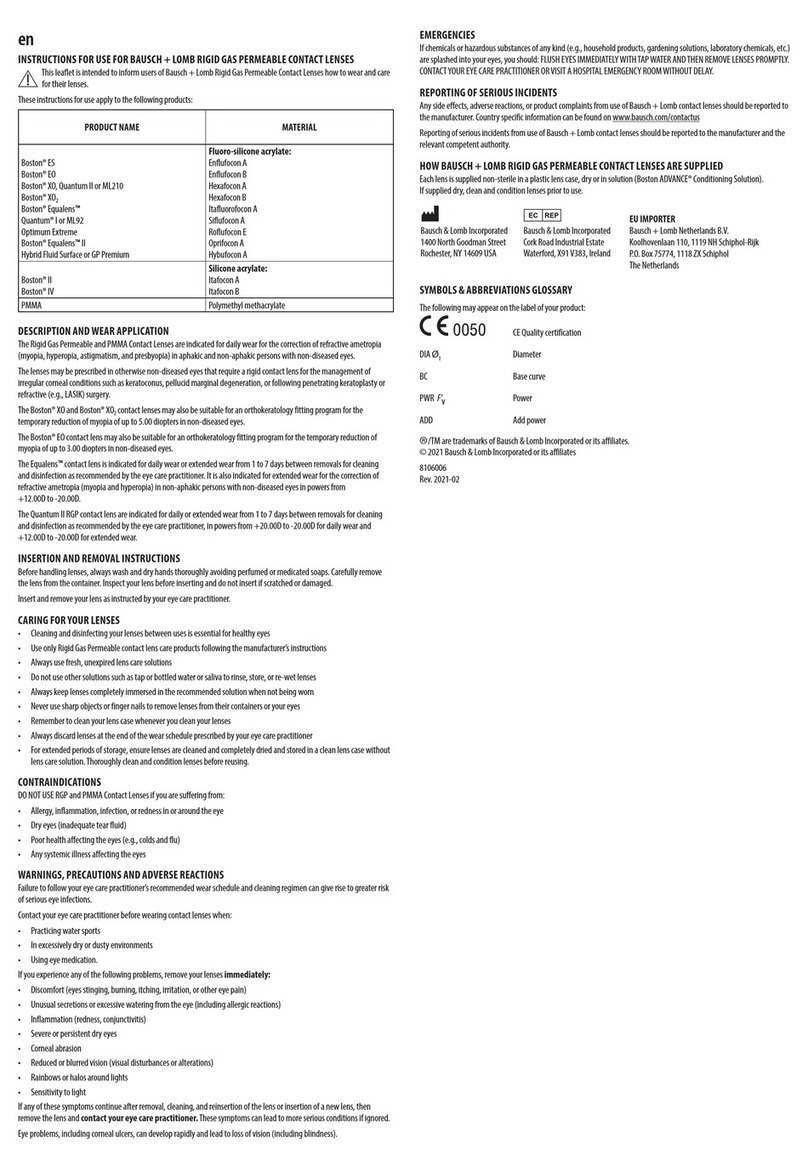
Bausch & Lomb
Bausch & Lomb Boston ES User manual

Bausch & Lomb
Bausch & Lomb ULTRA User manual
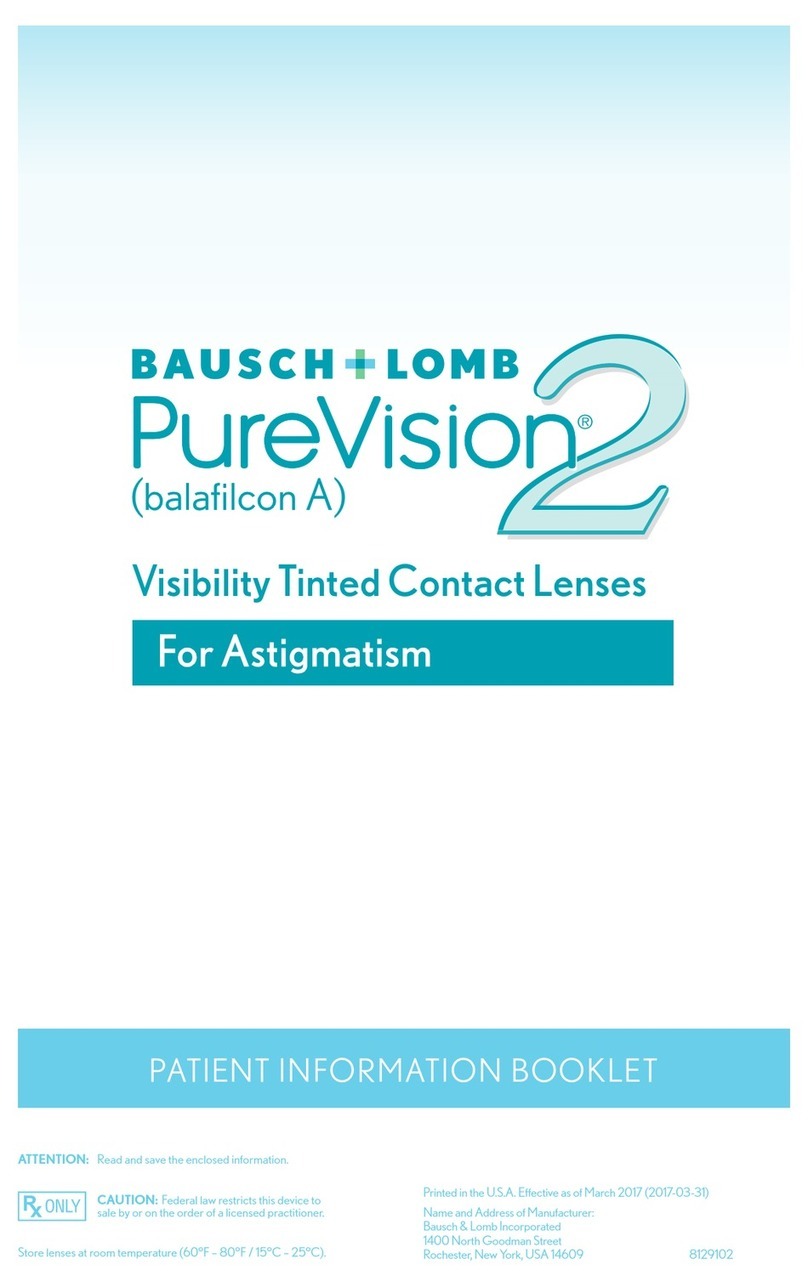
Bausch & Lomb
Bausch & Lomb PuerVision2 User manual
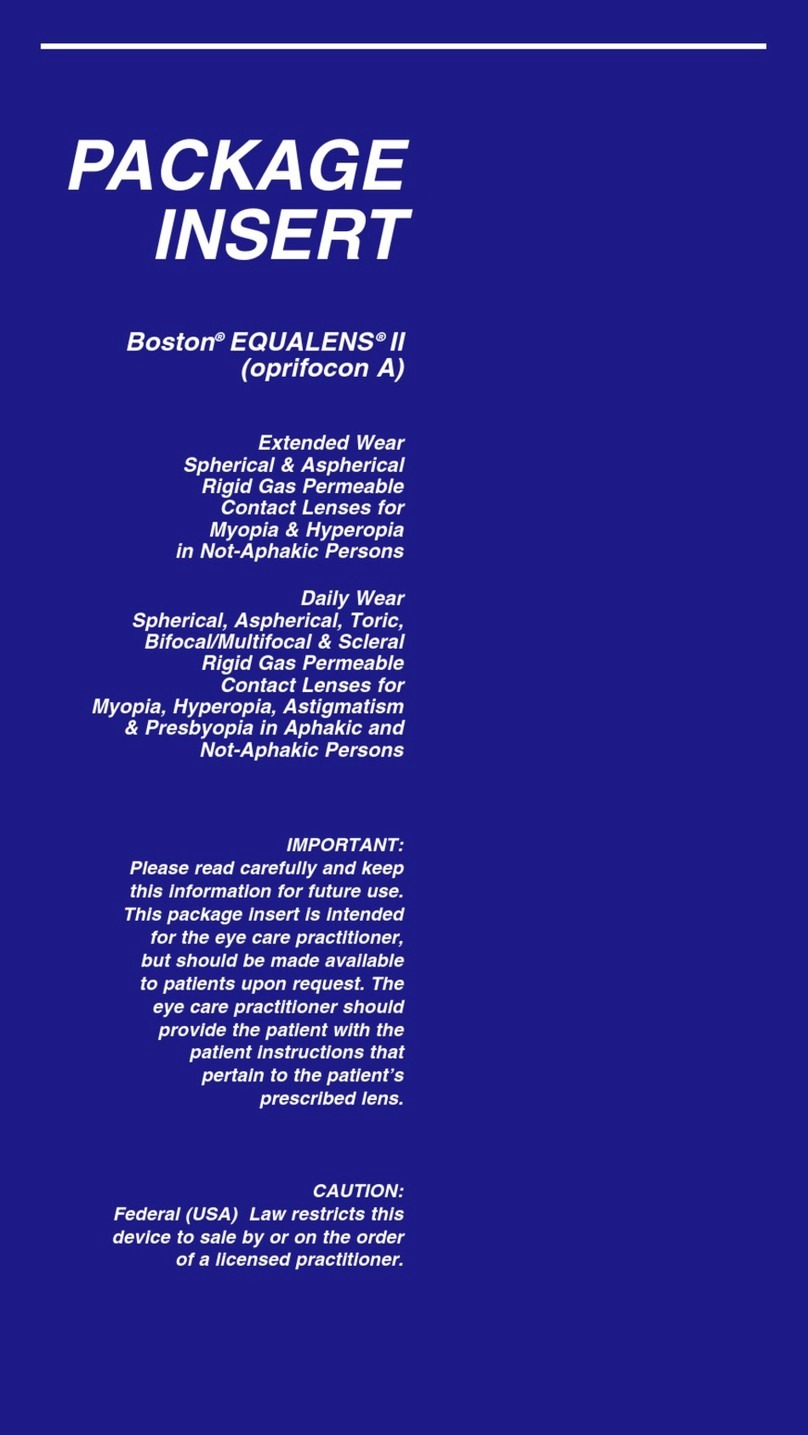
Bausch & Lomb
Bausch & Lomb Polymer Technology Boston Equalens II User manual

Bausch & Lomb
Bausch & Lomb SofLens 59 User manual
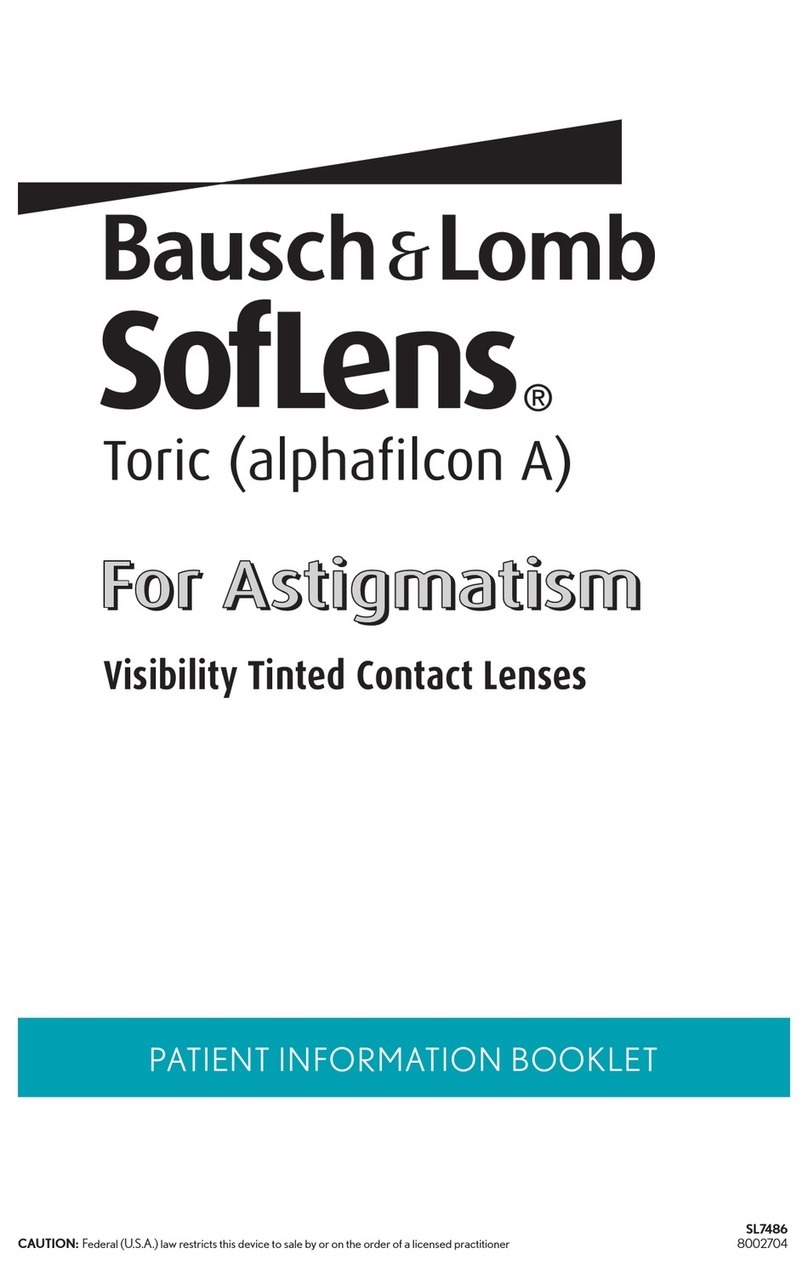
Bausch & Lomb
Bausch & Lomb SofLens Toric alphafilcon A User manual

